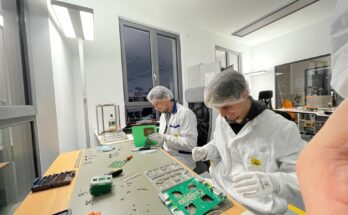A new MIT course this spring asked students to design what humans might need to comfortably work in and inhabit space. The time for these creations is now. While the NASA Apollo missions saw astronauts land on the moon, collect samples, and return home, the missions planned under Artemis, NASA’s current moon exploration program, include establishing long-term bases in orbit as well as on the surface of the moon.
The cross-disciplinary design course MAS.S66/4.154/16.89 (Space Architectures) was run in parallel with the departments of Architecture, and Aeronautics and Astronautics (AeroAstro), and the MIT Media Lab’s Space Exploration Initiatives group. Thirty-five students from across the Institute registered to imagine, design, prototype, and test what might be needed to support human habitation and activities on the moon.
“A lot of students at MIT are excited about space,” says Jeffrey Hoffman, one of the course instructors and professor of the practice in AeroAstro. Before teaching at MIT, Hoffman was a NASA astronaut who flew five missions aboard the space shuttle. “Certainly in AeroAstro, half the students want to be astronauts eventually, so it’s not like they hadn’t thought about living in space before. This was an opportunity to use that inspiration and work on a project that might become an actual design for real lunar habitats.”
MIT’s history with NASA, and with the Apollo missions in particular, is well documented. NASA’s first major contract for the Apollo program was awarded to MIT in 1961. Dava Newman, director of the MIT Media Lab and former NASA deputy administrator, was also a course instructor.
Preparing students for the next phase of working and living in space was the goal of this class. In addition to the Artemis missions, the rise of commercial spaceflight foretells the need to investigate these designs.
“MIT Architecture has always succeeded best at the intersection of research and practice,” says Nicholas de Monchaux, a course instructor and architecture department head. “With more and more designers being called on to design for extreme environments and conditions — including space — we see an important opportunity for research, collaboration, and new forms of practice, including an ongoing collaboration with the Media Lab and AeroAstro on designing for extreme environments.”
A defining aspect of the class is the blend of architecture and engineering students. Each group brought different mindsets and approaches to the questions and challenges put before them. Shared activities, guest lectures, and a week touring NASA’s Johnson Space Center in Houston, Texas; the SpaceX launch facility in Brownsville, Texas; and ICON’s 3D printing facilities for construction in Austin, Texas, provided the students with an introduction to teams already working in this field. Paramount among their lessons: an understanding of the harsh environments for which they will be designing.
“Space is one of the most hostile environments you can imagine,” he says. “You’re sitting inside a spacecraft looking out the window, realizing that on the other side of that window, I’d be dead in a few seconds.”
The students were divided into seven teams to develop their projects, and the value of collaboration quickly became apparent. The teams began with a concept phase where the visions of the architects — whose impulse was to create a comfortable and livable habitat — sometimes conflicted with those of the engineers, who were more focused on the realities of the extreme environment.
Inflatable designs emerged in several projects: a modular inflatable mobile science library that could support up to four people; an inflatable habitat that can be deployed within minutes to provide short-term shelter and protection for a crew on the moon; and a semi-permanent in situ habitat for space exploration ahead of an established lunar base.
“Architects and engineers tend to approach the design process differently,” says Annika Thomas, a mechanical engineering doctoral student and member of the MoonBRICCS team. “While it was a challenge to integrate these ideas early on, we found ways over time to communicate and coordinate our ideas, brought together by a common vision for the end of the project.”
Thomas’s teammates, architecture students Juan Daniel Hurtado Salazar and Mikita Klimenka, say that technical considerations in architecture are often resolved toward the middle and end of a project.
“This gives us too much space to put off the implications of our design decisions while leaving little time to resolve them,” says Salazar. “The insight of our engineers challenged every design decision from the onset with mechanical, economic, and technological implications of current space technology and material regimes. It also provided a fruitful arena to cooperatively discuss the concern that the most materially and economically optimal solutions are not always the most culturally or morally justified, as the emergence of long-term habitats brings the full gamut of an astronaut’s functional, social, and emotional needs to the forefront.”
Says Klimenka, “The wealth of knowledge and experience present within the team allowed us to meaningfully consider possible responses to producing a viable long-term habitat. While navigating both engineering and design constraints certainly required additional effort, the thinking process overall was extremely refreshing as we exposed ourselves to totally different sets of challenges that we do not typically deal with in our domains.”
Architecture graduate student Kaicheng Zhuang, who worked with engineers on the Lunar Sandbags project, says communication skills were “crucial” to the team working successfully together.
“With the engineers, it’s essential to focus on the technical feasibility and practical implementation, making sure every design element can be realistically achieved,” says Zhuang. “They needed clear, precise information about structural integrity, material properties, and functionality. On the other hand, within our architecture team, discussions often revolve around the conceptual and aesthetic aspects, such as the visual impact, spatial dynamics, and user experience.”
Molly Johnson, an AeroAstro graduate student and team member on the lunarNOMAD project, concurs. “Traditionally, for a systems engineer such as myself it is easy to wave away the small design details and say they’ll be addressed without going into detail about how they’ll be addressed. The architects brought in a new level of detail that helped clarify our intentions.”
The team behind Momo: a Self-Assembling Lunar Habitat created a mission profile for their design. The semi-permanent in situ habitat was designed for space exploration ahead of establishing a permanent base on the moon. The module is flexible enough to fold nearly flat for easy transport. Their project was recently profiled in DesignBoom.
The final projects showed the vast differences among the teams despite there being a “limited number of ways that you can actually keep people alive on the lunar surface,” says Cody Paige, director of Space Exploration Initiatives and a course instructor. Students needed to consider what types of materials were needed; how these would be transported and assembled; how long their structures would remain functional; and what social or human experience would be supported, among other concerns.
The hands-on experience to create life-size models was especially important in this course given that AI is becoming a larger component of so many tasks and areas of decision-making, according to Paige.
“A computer doesn’t always translate exactly into the real world, and so having the students make prototypes shows them that there is a lot of benefit in understanding the materials you’re working with, how they function in real life, and the tactile ability that you can gather by working with these materials,” says Paige.
As fantastical as some of the projects appeared — with their combination of architecture, engineering, and design — they may very well be viable soon, especially as more architects are hired to design for space and students are understanding the landscape and needs for the demanding environments.
“We need to train our students to be the pioneers at the forefront of this field,” says Skylar Tibbits, a professor in the architecture department and one of the course instructors. “The longer astronauts are in space or on the moon, we need to be designing habitats for human experiences that people will want to live in for a long time.”
The need for architects and engineers skilled in this specific field is thriving. Thomas — the engineering student on the MoonBRICCS team — is currently working on robotics for space application. Her teammate — Palak Patel — is an engineering doctoral student working on extreme environment materials for space applications. With the enthusiasm of the students, as well as the considerable real-world occupational need, the three academic units plan to continue to offer the course in the future.
“We see extending this into a multi-year program in designing for extreme environments — in space and on Earth — and are actively discussing sponsorships and partnerships,” says de Monchaux.
This website is managed by the MIT News Office, part of the Institute Office of Communications.
Massachusetts Institute of Technology77 Massachusetts Avenue, Cambridge, MA, USA



